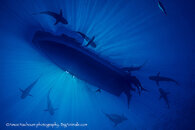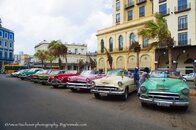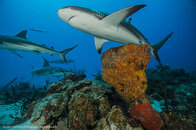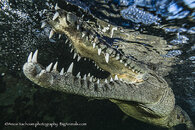Amos Nachoum
New
On my Big Animals trips, it’s the locals who make the difference in our journey. Observing Cubanos’ colorful, robust and up beat tempo overshadows the limitations I’ve observed imposed on their lives. They live in a city and countryside that is basically “frozen in time.” There is a fifty-year “time warp.”
San Cristóbal de la Habana or Havana, Cuba’s capital city is only a short ninety miles from Florida. Having visited the island country four times, I have fallen in love with its beauty, culture, and now its scuba diving. Yes, I would rate Havana as a city comparable to Paris, Rome, Oslo, London and even Shanghai.
Travel to Cuba is now permissible for US citizens through cultural exchange programs sanctioned by the US Office of Foreign Assets Control, which in the first phase of my journey gave me the freedom to interact in the daily activities of the Cuban community, experiencing their architecture, history, art, culture, and the music of daily life in and around Havana.
In the second phase of the trip, I visited the Gardens of the Queen to witness first hand the efforts being taken to preserve and protect a marine ecosystem that is unique to the southern coast of Cuba. “Jardines de la Reina” was declared a Marine Park in 1996. By limiting the number of divers per year to 1,500, this intricate network of untouched marine ecosystems will be preserved for future generations.
Part 1: HAVANA
Most visitors especially enjoy their time exploring Habana Vieja (Old), a beautifully restored collection of colonial buildings complete with winding cobblestone streets merging into central plazas. La Habana Vieja is one of the world’s more interesting colonial old towns. Designated a UNESCO site, the area includes more than 900 historical buildings with architecture varying from baroque to art deco.
Havana is undergoing a fast transformation, despite lingering limitations imposed by the government, from tourism from all over the world and now, unbelievably the United States of America. During my visit, in a few short days, I met Chinese, Japanese, Koreans, European of all nationalities, Canadians, Mexicans, Argentines and Brazilians.
In spite of the tourist influx, a day in Old Havana rivals a city tour anywhere. It is colorful and entertaining to wander the narrow streets bustling with people, some colorfully dressed and walking on stilts, through antique, unique building architecture lined with small shops.
El Floridita, Ernest Hemingway’s historic fish restaurant and cocktail bar hangout is famous for its daiquiris and mojitos. You can feel the tempo of the salsa music. In Havana “eye candy” is seeing a rainbow, those lime, pink, yellow, blue, plus black and white convertible and sedans dating back to the 1940s and 50s. Fully restored to their past glory, if we are lucky, we can find one for hire as a taxi.
Evening adds another flavor. It is time to eat well and there are great places to get fresh seafood and a variety of excellent paradores (private restaurants.) Vegas-type shows are a must as well as the Buena Vista Social Club. I danced the night away and like me, maybe you would like to feel that salsa tempo again, too.
Those forbidden (embargoed) Havana cigars are, well, just a puff of the temptation. Cigar blends, including the more popular and critically acclaimed Choiba, Monte Christi, and Romeo & Juliet can be purchased at wholesale factories at better prices plus the opportunity to see them hand made. A visit to a cigar factory and city art and historical museums offers a deeper respect of the country and its people. Not to be missed is the availability of 15-20-30 year old Santiago rum…a superb shot costs a dollar for each year of aging.
Part 2: GARDENS OF THE QUEEN
My visit to Havana was only the opener to my main event: diving at Jardines de la Reina, or Gardens of the Queen National Park. The nature reserve and archipelago is a large coral reef and mangrove forest, about 48 miles southeast of Cuba’s southern coast. Years ago, the Cuban Government granted a permit to just one operator to establish a floating commercial and conservation base.
The operation’s name is Avalon Cuba Fishing Centers. It is an Italian outfit. It began years ago with a floating headquarters and a few vessels for fishing, but later on it added diving services only after placing underwater hooks at the many good dive sites. No anchors need to be dropped on the fragile coral; heavy ropes lead to the surface and are attached to floating buoys. There are numerous dive sites, so there’s no need to dive on the same site every day, which allows the reef and wildlife to recover after divers visit.
The reefs in Gardens of the Queen are surprisingly untouched, and I have not spotted any broken corals in the area. At one site, there is a garden of more than five dozen elkhorn coral heads. They are beautifully situated in shallow water no more than 16 feet deep against a sandy bottom, with hard-coral polyps reflecting the sunlight, in a yellow glowing color amid thousands of fish. Porgy, schoolmaster, blue-striped grunt, and goatfish all roam in big numbers among the coral heads and arms.
At the Los Sabalos dive site, I discovered a complex array of grottoes and pillars. Amid those dramatic formations, I photographed a large school of tarpon hunting anchovies. All of a sudden, I heard Noel, my dive guide, screaming underwater through his regulator, and I raised my eyes above my viewfinder to see a 14-foot great hammerhead passing between Noel and me. Noel got it on his video. I got it in my personal memory bank.
Shark feeding also takes place on several dive sites. Divemasters carry boxes full of fish extracts, and then place the boxes among the coral heads. On my visit, it only took a few minutes for a dozen Caribbean reef sharks to start arriving from different directions. At one point, I counted more than 35 sharks. Lying on the sandy bottom at 45 feet, looking through the blue water at sharks circling above my head but exclusively fixated on the box with bait, I could even be careless about my bubbles.
At another location, the bait was used to attract silky sharks. They arrived even faster, and in greater numbers. To my delight, Noel advised me that if he removed the box from the reef, the sharks would follow him to the boat, leaving me alone to photograph the sharks swarming around the dive boat, all in the purest blue water. It was a fantastic photo opportunity, with numerous shark silhouettes beside the dive boat, all above me.
At still another site, la Finca de Pepe, Noel brought the bait box with him again, but this time it was to attract goliath groupers—each three- to four-feet-long, and weighing from 100 to 120 pounds. At the start, they were shy to approach us, but only a few minutes later, as we hovered in one place, a grouper was in my face and just above my camera dome.
The reef fishes here have no fear of divers. They don’t swim away, since no fishing or hunting has been allowed in these waters for many years. The shallow and healthy reef of yellow and black coral—plus red and purple sponges 10 to 15 feet below the surface—are all washed in bright sunlight, and colors of the fish will be vivid to your eyes.
Of course, I must also mention the presence of a few saltwater American crocodiles that are amazingly friendly. Yes, these crocs have been fed by the floating center for years. The local divemasters will make a call, and then the crocs come out of their hiding places among the mangroves to hang out beside the dive boats, hoping for a handout. The crocs here are small, from four- to five-feet-long.
At first, most divers elect to stay onboard, and take pictures from above of the crocs’ brownish yellow bodies against the refreshing blue water. However, as soon as one diver goes into the water and starts photographing them from the side, just two or three feet away, others realize that the approach is easy. As long as you do not touch the crocs, divers can approach one at a time and come home with exciting images of an animal that was once considered fearsome, but now the fear is gone and beauty is what remains.
The weather was superb during my spring stay, warm and sunny on the surface, with a water temperature rising to 82F (28C). A 3-mm or 1/8” wetsuit was just enough. Underwater visibility differs from low to high tide, ranging from 60 feet (20 meters) to 100 feet (30 meters). The operation’s newest liveaboard is the Avalon II—just one year old, 110-feet-long, and able to accommodate 16 people in eight fully air-conditioned double cabins, each with a private head and shower. There’s also a large diving deck, good diving gear for rent. Nitrox is also available.
What else can you ask for? Oh yes, a Jacuzzi on the top deck and superb meals, with pasta, lobster, shrimp, salads, and plenty of tropical fruits, including guava, pineapple and papaya. Experienced, polite, and accommodating dive guides all are English-speaking, as are key members of the crew. But the truth is that I must let my pictures tell the rest of the story.
Start your new year off in the best way possible by joining this BigAnimals expedition to the time capsule that is Cuba. Drink your New Years Eve bubbly on board the Avalon II and then spend the next week making your own bubbles and unforgettable memories in the warm, blue waters of Gardens of the Queen. For more information, please visit www.biganimals.com or email info@biganimals.com.
San Cristóbal de la Habana or Havana, Cuba’s capital city is only a short ninety miles from Florida. Having visited the island country four times, I have fallen in love with its beauty, culture, and now its scuba diving. Yes, I would rate Havana as a city comparable to Paris, Rome, Oslo, London and even Shanghai.
Travel to Cuba is now permissible for US citizens through cultural exchange programs sanctioned by the US Office of Foreign Assets Control, which in the first phase of my journey gave me the freedom to interact in the daily activities of the Cuban community, experiencing their architecture, history, art, culture, and the music of daily life in and around Havana.
In the second phase of the trip, I visited the Gardens of the Queen to witness first hand the efforts being taken to preserve and protect a marine ecosystem that is unique to the southern coast of Cuba. “Jardines de la Reina” was declared a Marine Park in 1996. By limiting the number of divers per year to 1,500, this intricate network of untouched marine ecosystems will be preserved for future generations.
Part 1: HAVANA
Most visitors especially enjoy their time exploring Habana Vieja (Old), a beautifully restored collection of colonial buildings complete with winding cobblestone streets merging into central plazas. La Habana Vieja is one of the world’s more interesting colonial old towns. Designated a UNESCO site, the area includes more than 900 historical buildings with architecture varying from baroque to art deco.
Havana is undergoing a fast transformation, despite lingering limitations imposed by the government, from tourism from all over the world and now, unbelievably the United States of America. During my visit, in a few short days, I met Chinese, Japanese, Koreans, European of all nationalities, Canadians, Mexicans, Argentines and Brazilians.
In spite of the tourist influx, a day in Old Havana rivals a city tour anywhere. It is colorful and entertaining to wander the narrow streets bustling with people, some colorfully dressed and walking on stilts, through antique, unique building architecture lined with small shops.
El Floridita, Ernest Hemingway’s historic fish restaurant and cocktail bar hangout is famous for its daiquiris and mojitos. You can feel the tempo of the salsa music. In Havana “eye candy” is seeing a rainbow, those lime, pink, yellow, blue, plus black and white convertible and sedans dating back to the 1940s and 50s. Fully restored to their past glory, if we are lucky, we can find one for hire as a taxi.
Evening adds another flavor. It is time to eat well and there are great places to get fresh seafood and a variety of excellent paradores (private restaurants.) Vegas-type shows are a must as well as the Buena Vista Social Club. I danced the night away and like me, maybe you would like to feel that salsa tempo again, too.
Those forbidden (embargoed) Havana cigars are, well, just a puff of the temptation. Cigar blends, including the more popular and critically acclaimed Choiba, Monte Christi, and Romeo & Juliet can be purchased at wholesale factories at better prices plus the opportunity to see them hand made. A visit to a cigar factory and city art and historical museums offers a deeper respect of the country and its people. Not to be missed is the availability of 15-20-30 year old Santiago rum…a superb shot costs a dollar for each year of aging.
Part 2: GARDENS OF THE QUEEN
My visit to Havana was only the opener to my main event: diving at Jardines de la Reina, or Gardens of the Queen National Park. The nature reserve and archipelago is a large coral reef and mangrove forest, about 48 miles southeast of Cuba’s southern coast. Years ago, the Cuban Government granted a permit to just one operator to establish a floating commercial and conservation base.
The operation’s name is Avalon Cuba Fishing Centers. It is an Italian outfit. It began years ago with a floating headquarters and a few vessels for fishing, but later on it added diving services only after placing underwater hooks at the many good dive sites. No anchors need to be dropped on the fragile coral; heavy ropes lead to the surface and are attached to floating buoys. There are numerous dive sites, so there’s no need to dive on the same site every day, which allows the reef and wildlife to recover after divers visit.
The reefs in Gardens of the Queen are surprisingly untouched, and I have not spotted any broken corals in the area. At one site, there is a garden of more than five dozen elkhorn coral heads. They are beautifully situated in shallow water no more than 16 feet deep against a sandy bottom, with hard-coral polyps reflecting the sunlight, in a yellow glowing color amid thousands of fish. Porgy, schoolmaster, blue-striped grunt, and goatfish all roam in big numbers among the coral heads and arms.
At the Los Sabalos dive site, I discovered a complex array of grottoes and pillars. Amid those dramatic formations, I photographed a large school of tarpon hunting anchovies. All of a sudden, I heard Noel, my dive guide, screaming underwater through his regulator, and I raised my eyes above my viewfinder to see a 14-foot great hammerhead passing between Noel and me. Noel got it on his video. I got it in my personal memory bank.
Shark feeding also takes place on several dive sites. Divemasters carry boxes full of fish extracts, and then place the boxes among the coral heads. On my visit, it only took a few minutes for a dozen Caribbean reef sharks to start arriving from different directions. At one point, I counted more than 35 sharks. Lying on the sandy bottom at 45 feet, looking through the blue water at sharks circling above my head but exclusively fixated on the box with bait, I could even be careless about my bubbles.
At another location, the bait was used to attract silky sharks. They arrived even faster, and in greater numbers. To my delight, Noel advised me that if he removed the box from the reef, the sharks would follow him to the boat, leaving me alone to photograph the sharks swarming around the dive boat, all in the purest blue water. It was a fantastic photo opportunity, with numerous shark silhouettes beside the dive boat, all above me.
At still another site, la Finca de Pepe, Noel brought the bait box with him again, but this time it was to attract goliath groupers—each three- to four-feet-long, and weighing from 100 to 120 pounds. At the start, they were shy to approach us, but only a few minutes later, as we hovered in one place, a grouper was in my face and just above my camera dome.
The reef fishes here have no fear of divers. They don’t swim away, since no fishing or hunting has been allowed in these waters for many years. The shallow and healthy reef of yellow and black coral—plus red and purple sponges 10 to 15 feet below the surface—are all washed in bright sunlight, and colors of the fish will be vivid to your eyes.
Of course, I must also mention the presence of a few saltwater American crocodiles that are amazingly friendly. Yes, these crocs have been fed by the floating center for years. The local divemasters will make a call, and then the crocs come out of their hiding places among the mangroves to hang out beside the dive boats, hoping for a handout. The crocs here are small, from four- to five-feet-long.
At first, most divers elect to stay onboard, and take pictures from above of the crocs’ brownish yellow bodies against the refreshing blue water. However, as soon as one diver goes into the water and starts photographing them from the side, just two or three feet away, others realize that the approach is easy. As long as you do not touch the crocs, divers can approach one at a time and come home with exciting images of an animal that was once considered fearsome, but now the fear is gone and beauty is what remains.
The weather was superb during my spring stay, warm and sunny on the surface, with a water temperature rising to 82F (28C). A 3-mm or 1/8” wetsuit was just enough. Underwater visibility differs from low to high tide, ranging from 60 feet (20 meters) to 100 feet (30 meters). The operation’s newest liveaboard is the Avalon II—just one year old, 110-feet-long, and able to accommodate 16 people in eight fully air-conditioned double cabins, each with a private head and shower. There’s also a large diving deck, good diving gear for rent. Nitrox is also available.
What else can you ask for? Oh yes, a Jacuzzi on the top deck and superb meals, with pasta, lobster, shrimp, salads, and plenty of tropical fruits, including guava, pineapple and papaya. Experienced, polite, and accommodating dive guides all are English-speaking, as are key members of the crew. But the truth is that I must let my pictures tell the rest of the story.
Start your new year off in the best way possible by joining this BigAnimals expedition to the time capsule that is Cuba. Drink your New Years Eve bubbly on board the Avalon II and then spend the next week making your own bubbles and unforgettable memories in the warm, blue waters of Gardens of the Queen. For more information, please visit www.biganimals.com or email info@biganimals.com.








